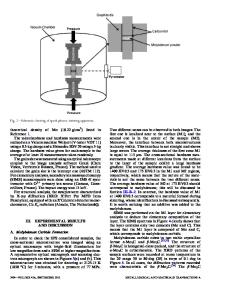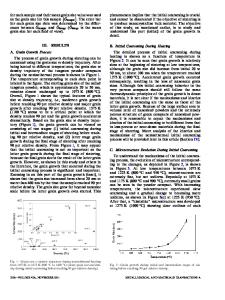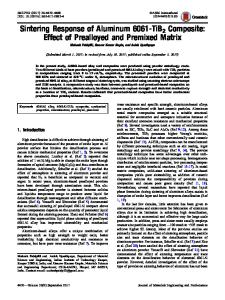Supersolidus liquid-phase sintering of prealloyed powders
- PDF / 574,442 Bytes
- 15 Pages / 612 x 792 pts (letter) Page_size
- 22 Downloads / 353 Views
I.
INTRODUCTION
THE formation of a liquid during sintering is a common technique to enhance densification. Typically, liquid-phase sintering begins by mixing two or more small powders of differing compositions.[1] On heating, one powder melts or reacts to form a liquid between the particles that engulfs the more refractory phase. If the particle size is small, then capillary forces from the wetting liquid enhance densification.[2] The process consists of several overlapping steps involving solid-state diffusion, particle rearrangement, solution reprecipitation, and solid skeleton densification. After sintering, the product is a composite of refractory grains interlaced with a solidified liquid. To obtain a significant advantage from the liquid requires a large capillary force from the wetting liquid, which in turn mandates a small initial particle size, often in the range of 1 mm or less. A variant to traditional liquid-phase sintering is to use alloy powders, which are heated to a temperature between the liquidus and solidus. The liquid forms inside the particles and spreads to the particle contacts, resulting in a capillary force acting on the semisolid particles. This process is termed supersolidus liquid-phase sintering (SLPS).[3] Densification is rapid once sufficient liquid forms to fragment the particles into individual grains. In this case, even large particles exhibit rapid densification. The widespread implementation of powder atomization technologies capable of producing large quantities of alloy powders in the 20- to 250-mm size range provides a new opportunity for SLPS. Normally, these powders are too coarse for use in traditional liquid-phase sintering, but they prove ideal for supersolidus sintering. Additionally, the full density, high alloy, and homogeneous microstructure of the sintered products result in higher mechanical properties as compared to traditional powder metallurgy products. Densification during SLPS is analogous to viscous flow sintering, because the semisolid particles turn mushy and RANDALL M. GERMAN, Brush Chair Professor in Materials, is with the Department of Engineering Science and Mechanics, The Pennsylvania State University, University Park, PA 16802-6809. Manuscript submitted September 13, 1996. METALLURGICAL AND MATERIALS TRANSACTIONS A
flow once liquid spreads along the grain boundaries. The viscosity decreases as the liquid volume fraction increases, so more liquid makes for faster sintering, but less dimensional precision. Consequently, temperature (which controls the solid-liquid ratio) is a main determinant of sintered density and dimensional precision. As illustrated by the data in Figure 1, densification depends on attaining a critical temperature.[4] This plots the sintered density of a 30-mm nickel-based alloy powder vs sintering temperature for compacts initially 62 pct dense. Densification occurred over a narrow temperature range. Prolonged holds in the presence of the liquid phase result in microstructure coarsening with concomitant property decrements. Furth
Data Loading...











